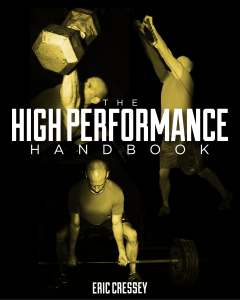Strength Training Programs: 3 Habits to Make You a Better Lifter
Today’s guest post comes from Cressey Sports Performance coach, Andrew Zomberg.
Habitual behavior happens unconsciously and compulsively. Daily activities like brushing your teeth or setting your alarm before bed are programmed into your brain simply because of the repetitive nature in which you carry out these actions. You want to create the same kind habitual behavior in your lifting routine. But, building these habits requires specificity. In other words, it is not enough to say, “I want to be a more efficient lifter.” This big goal needs to be broken down into small, specific behaviors in order to make the change attainable.
Below are three important habits to establish in your lifting routine. These behaviors will pave the way to efficiency. Just know, reinforcing them will take time. According to a 2009 study from London’s University College, it takes 66 days to successfully adopt a new habit. What does this mean? At first, you will have to work hard at implementing them into your lifting routine – so don’t get discouraged! Eventually, these habits will become second nature, and you will incorporate them without even thinking about it.
1. Create structure. Structure provides a baseline to achieve your fitness goals. By planning things out and establishing a purpose to be at the gym, you can ensure quality and consistency in your workouts. Structure also makes it easier to stick to a program long-term. But planning requires effort and discipline, especially in the preparation phase. To make structure and organization a habit, aim to:
- Write everything down. This includes the load (amount of weight lifted), any modifications (regressions, progressions, etc.), and the settings (cable column adjustments, hand placements, stance, etc.). It is not practical to remember exactly what you did last week, so take the guesswork out. Keeping track of your workouts is also highly motivational. Tracking your progress provides positive feedback and reminds you just how hard you are working to attain the end goal.
- Execute the program without deviation. Program designs are created for a reason. Exercise choice and exercise order aren’t just arbitrary recommendations that can be ignored. Sure, warm-ups can be boring, and of course it is easier to do a lat pull down than a chin-up, but there are no shortcuts to speed, strength and growth. So, stick to the plan!
- Improve your accountability to minimize hiccups in your programming. If you have a work commitment, schedule your training session around it. If you have an injury, find a way to safely work out. If you often make excuses to skip a weekend workout, train with a partner to increase your accountability to get the gym.
2. Improve the proficiency of each lift. Awareness is underrated in fitness. Take single-leg work, for instance. Many “lungers” allow their knee to translate too far forward, which yields premature heel lift. Unbeknownst to their knowing, this redistributes the stress to unwanted areas and simply doesn’t target the intended areas (the hamstrings and glutes). It is so important to hone in on proper technique to ensure stability, proper body alignment, movement quality, and of course, safety. In order to improve proficiency in your programming, make a habit to:
- Learn the right way to do each exercise. There are plenty of experts in the field who have mastered specific lifts from whom you can learn. However, please keep an open mind. Do not get caught up with just one individual. By learning from several enthusiasts, you are exposed to many different physical and verbal cues that will help perfect your lifts.
- Practice lifts and all of their steps. There are several key components of a lift, including (but not limited to) the set-up, the tempo of the ascent/decent, and the lockout of the movement. Do not race through exercises. Take the time to execute the movements in their entirety in order to maximize results.
- Figure out the limiting factors. These factors may include, mobility or stability restraints, lack of kinesthetic awareness or a pre-existing injury that is preventing the proper execution of a movement. There are several ways to reveal these issues. Watch videos. Work with a training partner. Get assessed by a trained professional, like an athletic trainer, physical therapist, or chiropractor. It is essential to address limiting factors because if you continue to perform in faulty movements, they will become ingrained, which prohibits growth and could eventually lead to further injury.
3. Add variations to programs and exercises. Variations are different ways of executing movements to increase or decrease the level of difficulty, eliminate monotony or simply expand your existing knowledge base. Adding variety to your programming will not only create the necessary adaptations for growth, but it will also enhance your level of expertise in specific lifts. Variations are effective on a monthly basis. To add variations in your programs, strive to:
- Manipulate the volume. Changing your reps and sets by either adding more or less weight in your current program will provide the muscular disturbances needed for noticeable and consistent growth.
- Add more exercises to your toolbox. Your muscles will not get stronger unless you force them to do so. By utilizing different exercises, you impose new stresses to the body, eliminating monotony and allowing for adaptation. This change leads to an endless list of benefits, including the improvement of cardiovascular health, the enhancement of body composition, and the development of quality of movement.
- Play around with additional training variables. Alter your base of support (stance), create new ranges of motion (deficits or partials), adjust your grip placement or modify your tempo. Changing the variables not only warrants growth, but also helps you avoid plateaus. Remember, repetition allows the body to adapt to the repetitive motions, so mix it up – on a monthly basis!
Andrew Zomberg is a strength and conditioning coach at Cressey Sports Performance. You can follow him on Twitter: @AndrewZomberg.



